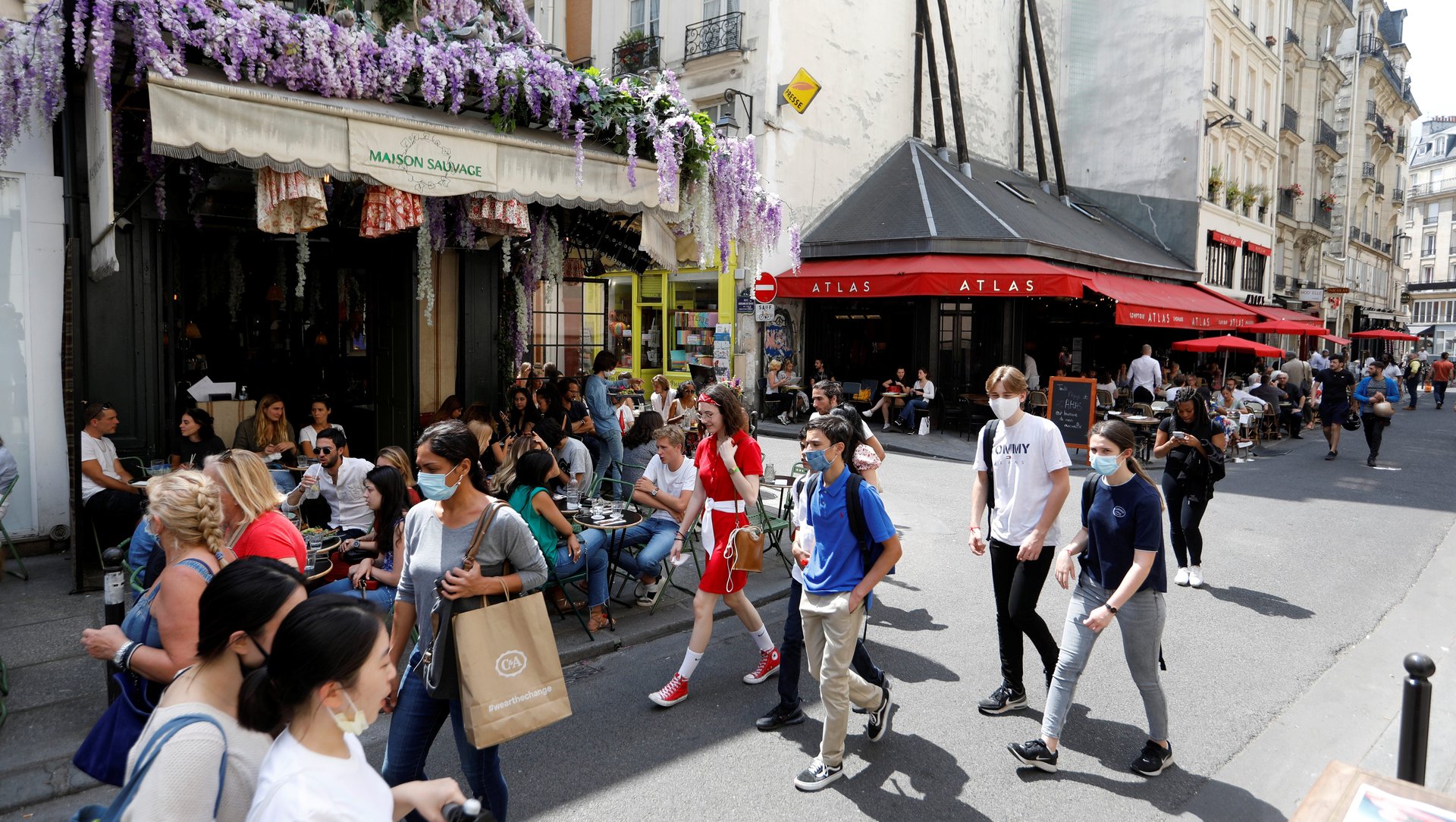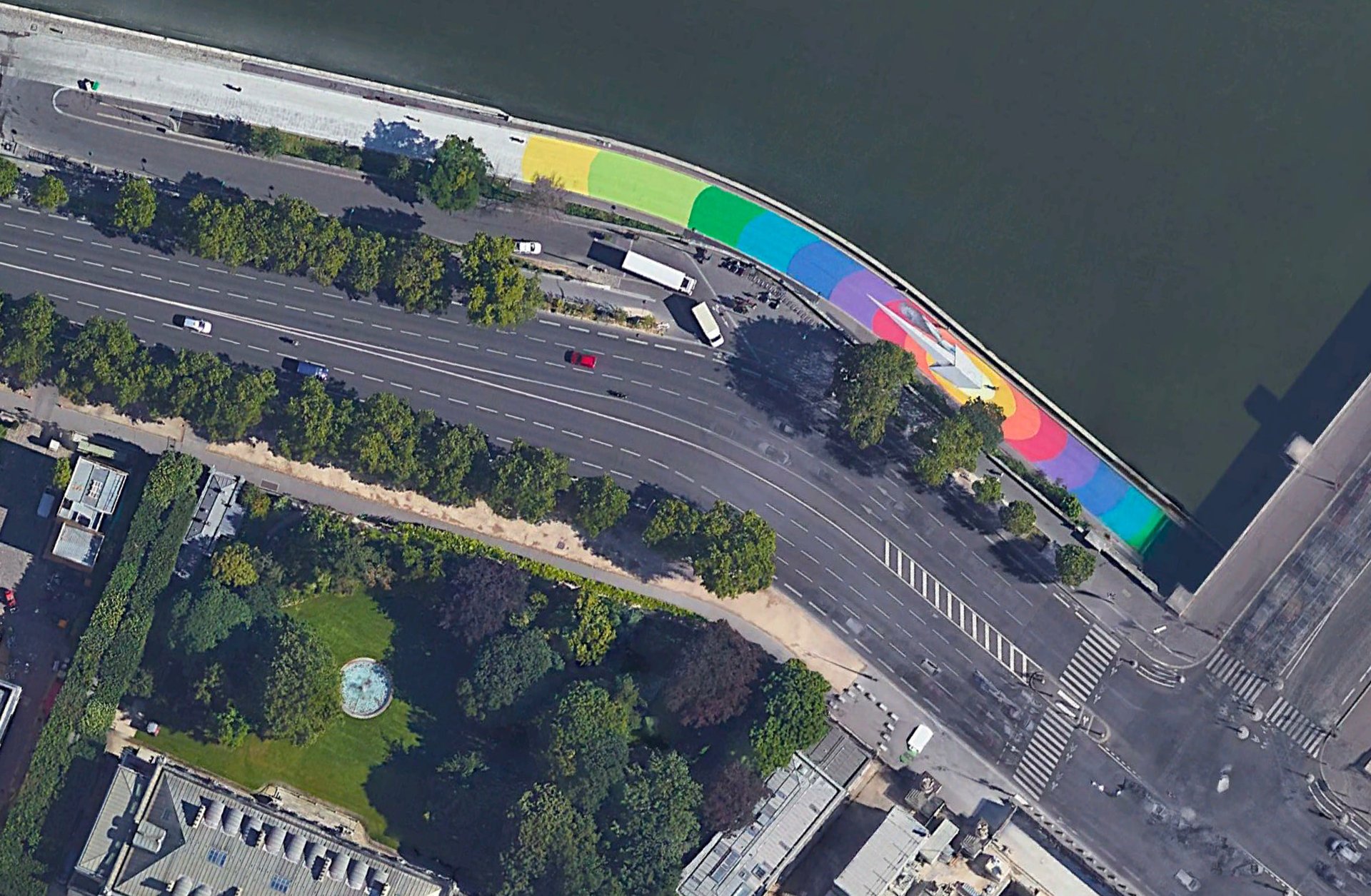Paris is purposefully walkable—and has lessons for post-pandemic cities
As restrictions on movement slowly lift across the world, people are stepping out—to commute, protest, and convene—on to streets visibly changed by the coronavirus pandemic. As cities grapple with the unique transportation challenge of keeping their citizens apart, Covid-19 has provided an opportunity to reimagine our roads.


As restrictions on movement slowly lift across the world, people are stepping out—to commute, protest, and convene—on to streets visibly changed by the coronavirus pandemic. As cities grapple with the unique transportation challenge of keeping their citizens apart, Covid-19 has provided an opportunity to reimagine our roads.
The history of Paris offers us something of a parallel. By the mid-19th century the French capital was reeling from decades of violence and disease. Cholera was in the water, and the end of the 1848 revolution lingered in the air. In 1853, Napoleon III tasked Georges-Eugène Haussmann with modernizing the city. The French official opened up the city’s dense medieval alleyways, transforming them into the broad boulevards Paris is famous for today, relieving overcrowding and resulting in a healthier, more beautiful and open city. (The new expansive streets also helped to hinder insurrectionists and provide quick passage for troops.)
The resulting design, which created a core with numerous expansive and walkable streets, has helped the city of Paris navigate its Covid-19 reopening more successfully than others. But so has modern politics and policy. The city’s socialist mayor, Anne Hidalgo, has been actively reorienting streets to favor walkers and cyclists since 2014. Motivated by the climate and health crises resulting from the city’s famously high pollution levels, Hidalgo has spent the last few years banning automobiles in many places, redesigning historical intersections, and shutting major thoroughfares, including one along the Seine which is now a 3.3 km (2 miles) long car-free zone in the heart of the city. Barge restaurants float alongside, games are painted on the pavement for children, and in the summer cafés pop up along the walk. Today, Paris has the greatest percentage of people in a European city that count walking as all or part of their commute.

As we maneuver toward a post-pandemic reality, there’s a strong case to be made for municipal programs like Hidalgo’s Paris piéton — Paris for pedestrians. The popularity of her initiatives was confirmed June 28, when she was reelected for another six-year term. Her reelection platform included a proposal for a “15-minute City”—one in which essentials are all within a short walk or cycle for all Parisians. She’s promised bike-lanes on all roads by 2024, and the removal of 74% of all on-street car parking.
“It is out of the question that we allow ourselves to be invaded by cars, and by pollution,” Hidalgo told the Paris city council when asked in April if she would ease car restrictions on the city as lockdown lifted. “Pollution is already in itself a health crisis and a danger—pollution joined up with coronavirus is a particularly dangerous cocktail.”
Driven by Hidalgo’s convictions, the city is fostering a diversity of uses for streets and strengthening a culture of walking in the French capital. Paris is reclaiming space for pedestrians, and providing lessons for cities building for a post-Covid reality.

Cut down on cars
As the world awaits a Covid-19 vaccine, and social distancing becomes the norm, the public transportation capacity of cities has become severely diminished, forcing centers to find the space to absorb many more individual trips. Many commuters, especially those anxious to return to public transportation, are turning to cars in response.
Cities hoping to dissuade people from driving might look to the initiatives put in place by Paris. Lowered speed limits, reduced hours for older vehicles in the center, fewer available parking spaces, dogged pro-bike campaigns, and, crucially, extensive cycle paths and programs, discourage many from getting behind the wheel. Fewer cars on the road means reduced pollution, quieter streets, and room for more compact modes of mobility, like walking, cycling, and public transportation.
Giving space to pedestrians and cyclists means taking it away from others, and such anti-car initiatives are not universally loved. Opponents suggest Hidalgo’s initiatives have simply displaced traffic elsewhere and snarled commutes. They also criticize the focus on central Paris, arguing that it ignores and penalizes citizens in the outer suburbs that may have no other option for getting around. Motorist groups also fear that her war on older and diesel cars will disproportionately hurt those who cannot afford to replace their vehicles.
Cities will need to keep these downsides in mind as they turn to similar initiatives to open up streets, and the coronavirus has already sparked interesting experiments. Athens has created temporary car-free areas. New York has temporarily prohibited cars on 64 km (40 miles) of major roads to allow crowded citizens to spread out. London has increased congestion charges for incoming traffic, while Bristol has banned cars from its city centers altogether.
In Milan, plans are underway to turn 35 km of streets to pedestrians and cyclists. “We worked for years to reduce car use. If everybody drives a car, there is no space for people, there is no space to move, there is no space for commercial activities outside the shops,” Marco Granelli, a deputy mayor of Milan, told the Guardian. “Of course, we want to reopen the economy, but we think we should do it on a different basis from before,” Granelli says.

Share the streets
Becoming pedestrian friendly isn’t just about getting rid of cars. In many cities, current sidewalk widths aren’t sufficient to safely accommodate more pedestrians, especially now that people need space not just for walking, but also for queueing outside stores.
Before the pandemic, Paris was expanding pedestrian space in mixed-use zones. Large-scale initiatives redeveloped seven of the city’s famous squares—some designed by Haussmann himself, such as Place de la Madeleine and Place de la Bastille—to give more room to walkers, cyclists, and tourists.
After Covid-19 hit, the city ramped up plans to separate citizens by redeveloping space around transportation stations and major shopping streets, as well as some schools and public facilities.
Other cities are reacting to Covid-19 by either temporarily or permanently implementing sidewalk extensions and reallocating lanes, curbs, and parking spaces so that walkers can allow for more comfortable social distancing strategies. Examples include walkways carved from car lanes (Burlington), reduced parking capacity (Glasgow), and pop-up street improvements (New South Wales).

Dedicate public space to communities
Reforming streets and sidewalks to favor pedestrians is also about creating lively, vibrant communities and neighborhoods. Paris has done this by developing “children’s streets”—roads normally open to vehicles but closed periodically for children to enjoy. Temporary barriers are placed to block traffic, volunteers arrive, games are provided, and paintings on the pavement encourage play.
As the pandemic prevents patrons from congregating inside, restaurants and cafés are having to find space to serve enough customers. In Paris, the streets are again the answer. Until the end of September, dining establishments are permitted to temporarily extend or create terraces, allowing some to expand into streets and parking lanes.
Cities reacting to Covid-19 by either temporarily or permanently dedicating outdoor street space to dining are putting restaurants in the road (Vilnius), using street art to brighten commutes (Edinburgh), and by creating parking lot patios (Ottawa) and parks (Vancouver).

Small acts are good, too
Initiatives don’t have to be expensive. Paris has found large and small ways to push its roads towards a people-focused future. According to Paris’ participatory budget—an initiative that allows citizens to suggest and vote on how the city should spend a portion of its budget each year—a number of pedestrian-focused projects were relatively economical. Installing benches and painting games for children on a car-free street, for example, cost € 20,000 ($22,600).
The pandemic has inspired some cities to enact creative, resource-light ways of putting pedestrians first, from altering the duration of walk lights in order to prevent curbside clusters of pedestrians, to rethinking way-finding by clearly labelling pop-up paths. Liverpool has created new street furniture, places like Washington D.C. have reduced traffic speeds, and yet others have developed creative road stencils to mark pathways and required distancing.
For cities hoping to use this unique period to launch reforms like closing streets, banning cars, and widening sidewalks, the key to long-term success will rely significantly on thoughtful consideration of all affected communities, especially those on the margins. Historically, transit revolutions have disproportionately and negatively affected poorer and minority communities. Cities should take care that initiatives to push pedestrian-friendly plans don’t instead leave some with fewer mobility options than before.
These initiatives will pose a stark challenge for cities that have been developed around cars, and that lack even the simplest of pedestrian-friendly designs. But the challenge is not impossible, and could be well worth it. Just as cholera and revolution influenced Haussmann and the streets of Paris nearly two hundred years ago, the decisions made today could last far into the future.
This article was updated with news of Anne Hidalgo’s reelection as mayor of Paris.